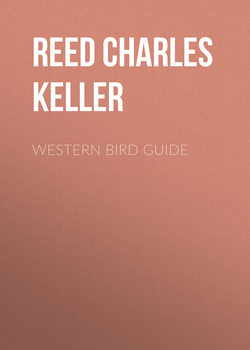Читать книгу Western Bird Guide - Reed Charles Keller - Страница 2
DIVING BIRDS – Order Pygopodes
GREBES – Family Colymbidæ
ОглавлениеWESTERN GREBE
1. Æchmophorus occidentalis. 25 to 29 inches
This is the largest of the grebe family. In summer the back of the neck is black, but in winter it is gray like the back.
Nest.– A floating mass of decayed rushes, sometimes attached to the upright stalks; 2 to 5 pale bluish white eggs are laid, usually much nest stained (2.40 × 1.55). Breeding in colonies.
Range.– Western North America, from the Dakotas and Manitoba to the Pacific, and north to southern Alaska.
HOLBOELL GREBE
2. Colymbus Holboelli. 19 inches
This is next to the Western Grebe in size, both being larger than any of the others. In summer, they are very handsomely marked, as shown in the illustration, but in winter have the usual dress of gray and white.
Nest.– Similar to above, the eggs averaging smaller (2.35 × 1.25).
Range.– North America, breeding from northwestern Alaska, in the interior of Canada and North Dakota. Winters usually on the coasts.
HORNED GREBE
3. Colymbus auritus. 14 inches
In winter this Grebe is one of the plainest in its dress of gray and white, but summer brings a great change, making it one of the most attractive, with its black, puffy head, and buffy white ear tufts, the front of the neck a rich chestnut color. Their food consists almost wholly of small fish.
Nest.– Is a loosely built mass of vegetation floating in the bog and water holes of the western prairies. The eggs, 3 to 7 in number, are brownish yellow (1.70 × 1.15).
Range.– Breeds from Dakota and Illinois northward; winters to the Gulf of Mexico.
EARED GREBE
4. Colymbus nigricollis californicus. 13 inches
This species is rarely found as far east as the Mississippi River. In summer the neck is black, lacking the chestnut color of the former. It can always be distinguished from the Horned by the upper mandible being straight on the top.
Nest.– In colonies similar to the above, laying from 3 to 8 eggs, which are usually nest stained to a brownish cream color.
Range.– From the Mississippi to the Pacific, nesting from Texas to British Columbia.
PIED-BILLED GREBE
6. Podilymbus podiceps. 13½ inches
This species cannot be mistaken for any others of the grebes in any plumage, because of its stout compressed bill and brown eyes, all the others having red eyes. In summer the bill is nearly white, with a black band encircling it; the throat is black; breast and sides brownish-gray; the eye encircled with a white ring.
Nest.– Made of a mass of decayed weeds and rushes, floating in shallow ponds or on the edges of lakes among the rushes. Five to 8 brownish white eggs are laid (1.70 × 1.18).
Range.– Whole of N. A., breeding in small colonies or pairs.
LOON; GREAT NORTHERN DIVER
7. Gavia immer. 31 to 35 inches
In shape and motions the loons very much resemble the grebes, except in size, being much larger. The common loon is the most beautiful of them all, having a velvety black iridescent head with slashes of white on the throat and neck and spots of white on the wings and back.
Nest.– Usually built under some shelter of bushes or rushes on the edge of some of the larger ponds or lakes. The two eggs are a yellowish brown, with black spots (3.50 × 2.25).
PACIFIC LOON
10. Gavia pacifica. 30 to 32 inches
This species differs from the Loon in having the crown gray, and white streaks down the back of the neck, and in the color reflections of the black on the head. It is a trifle smaller also.
Nest.– Similar to the former, the eggs being more of a greenish brown, with the black spots mostly on the larger end (3.10 × 2).
Range.– Western N. A., breeding in Alaska and British Columbia; winters along the Pacific coast to Mexico.
RED-THROATED LOON
11. Gavia stellata. 25 inches
The smallest of the Loon family. The back and head are gray, there is a large patch of chestnut on the fore-neck; under parts white. Owing to the straight top to the upper mandible the bill has a slightly up-turned appearance.
Nest.– Similar to the other Loons, placed within a few feet of the water. The eggs are an olive brown with more markings usually than the others, and mostly on the larger end (2.90 × 1.75).
Range.– Along the western coast of North America.
